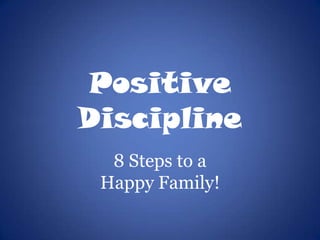
Positive discipline powerpoint
- 1. Positive Discipline 8 Steps to a Happy Family!
- 2. Expect It…….Teach It We must model the behaviors we expect from our children. In reality, they watch and learn from us. Talk to your children at their level, eye to eye. Stop what you are doing to completely listen when your child is telling you something that is important to them. We expect them to stop and listen, why shouldn’t we?
- 3. Rules and Consequences Children should have certain expectations at home just as they do at school. When a child is taught a rule at home he/she should know what the consequences will be if that rule is broken. If needed, post the rules and consequences somewhere you child will see them. Example: “Johnny, you are not suppose to leave your dirty clothes on the bathroom floor. You know they must be put in the laundry basket. If not, they will not get washed for you to wear. You will need to wash them your self.”
- 4. Logical Consequences Your child needs logical consequences when they break a rule. The consequences need to be age and developmentally appropriate for the child. The consequence should fit the mistake. Example: If Johnny is only 3, he does not need to be washing his own clothes. This is our job as parents.
- 5. Set Limits Don’t threaten to do something that you are not willing to follow through on. In the heat of the moment, it is very easy to say something that we do not really mean. Example: “I can’t believe you didn’t pass your math test! You are grounded for two months!”
- 6. Be Consistent Children are a lot smarter than we sometimes believe. If we say we are going to give them a consequence but never follow through with or only give it sometimes, the child will not think we are serious. We should give a consequence for misbehavior each time to reduce the incidence of that behavior.
- 7. Choices Children LOVE choices! This is a very effective tool when it comes to getting your child to do something you want them to do. Example: “Sally, you need to clean your room. You can do it now or after you finish breakfast.”
- 8. Timer Many times we find that younger children are much more interested in doing chores, homework, etc. if they think it is a game. Set a timer and tell the child, “Let’s see if you can beat the timer!” Make this a positive, fun experience. You could be the timer also. “I will go make my bed while you make yours. Let’s see who can do it the fastest! On your mark, get set, go!”
- 9. Behavior Chart Positive Behavior Charts are tried and true tools that teachers use in their classrooms to reinforce positive behavior while decreasing negative behavior. Place a behavior chart on the refrigerator, bathroom mirror, or the child’s bedroom door. Each time your child exhibits a behavior that is pleasing to you, give him/her a sticker. IMPORTANT: Discuss ahead of time with your child what reward they would like to receive once they have earned a certain number of stickers.
- 10. Any questions?